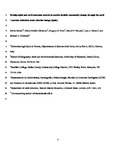Stratigraphic and environmental control on marine benthic community change through the early Toarcian extinction event (Iberian Range, Spain)
| dc.contributor.author | Danise, Silvia | |
| dc.contributor.author | Clémence, M-E | |
| dc.contributor.author | Watanabe, Sayaka | |
| dc.contributor.author | Murphy, DP | |
| dc.contributor.author | Gómez, JJ | |
| dc.contributor.author | Twitchett, RJ | |
| dc.date.accessioned | 2019-04-05T11:27:29Z | |
| dc.date.available | 2019-04-05T11:27:29Z | |
| dc.date.issued | 2019-06-15 | |
| dc.identifier.issn | 0031-0182 | |
| dc.identifier.issn | 1872-616X | |
| dc.identifier.uri | http://hdl.handle.net/10026.1/13668 | |
| dc.description.abstract |
In the Early Jurassic (~183 Ma ago) global warming and associated environmental changes coincided with an extinction event in the marine realm (early Toarcian extinction event). Anoxia was previously considered to have been the main cause of extinction, but extinctions also occur at localities that remained oxygenated throughout the event, suggesting that other factors, such as temperature, may have played a major role. To test this hypothesis, we integrated quantitative analyses of benthic macro-invertebrates with high-resolution geochemical proxies on the bulk rock (TOC, δ 13 C, δ 18 O) and on belemnites and brachiopod shells (δ 13 C, δ 18 O) from two sections from the Iberian Range, Spain, with no black shale deposition. The sections are orientated SE-NW along an onshore-offshore gradient deepening to the north. The dominant benthic groups, bivalves and brachiopods, show a different response to the extinction: brachiopods go through a complete species-level turnover, while many bivalve species range through the event. In the shallower section, changes in richness and evenness correlate with TOC (Total Organic Carbon), suggesting that variations in nutrient input from runoff, and the possible local onset of low-redox conditions (TOC > 4 wt%), controlled faunal diversity. In contrast, at the deeper section, community change correlates with changes in δ 18 O, indicating that temperature variations might have influenced faunal change. Different stratigraphic patterns of extinction occur between the two localities, with last-occurrences clustering at the maximum flooding surface in the shallower section, and at the transgressive surface in the deeper one. The observed differences between the two localities highlight the important role of local sedimentary and stratigraphic processes in controlling the shape of the geochemical and fossil record, and the need for studying multiple sections along onshore-offshore gradients in order to extrapolate regional and global patterns. | |
| dc.format.extent | 183-200 | |
| dc.language | en | |
| dc.language.iso | en | |
| dc.publisher | Elsevier | |
| dc.subject | Jurassic | |
| dc.subject | Warming | |
| dc.subject | Anoxia | |
| dc.subject | Bivalves | |
| dc.subject | Brachiopods | |
| dc.subject | Stable isotopes | |
| dc.title | Stratigraphic and environmental control on marine benthic community change through the early Toarcian extinction event (Iberian Range, Spain) | |
| dc.type | journal-article | |
| dc.type | Journal Article | |
| plymouth.author-url | https://www.webofscience.com/api/gateway?GWVersion=2&SrcApp=PARTNER_APP&SrcAuth=LinksAMR&KeyUT=WOS:000469154700014&DestLinkType=FullRecord&DestApp=ALL_WOS&UsrCustomerID=11bb513d99f797142bcfeffcc58ea008 | |
| plymouth.volume | 524 | |
| plymouth.publication-status | Published | |
| plymouth.journal | Palaeogeography, Palaeoclimatology, Palaeoecology | |
| dc.identifier.doi | 10.1016/j.palaeo.2019.03.039 | |
| plymouth.organisational-group | /Plymouth | |
| plymouth.organisational-group | /Plymouth/Faculty of Science and Engineering | |
| plymouth.organisational-group | /Plymouth/Faculty of Science and Engineering/School of Geography, Earth and Environmental Sciences | |
| plymouth.organisational-group | /Plymouth/REF 2021 Researchers by UoA | |
| plymouth.organisational-group | /Plymouth/REF 2021 Researchers by UoA/UoA07 Earth Systems and Environmental Sciences | |
| plymouth.organisational-group | /Plymouth/Research Groups | |
| plymouth.organisational-group | /Plymouth/Research Groups/Marine Institute | |
| plymouth.organisational-group | /Plymouth/Users by role | |
| plymouth.organisational-group | /Plymouth/Users by role/Academics | |
| plymouth.organisational-group | /Plymouth/Users by role/Researchers in ResearchFish submission | |
| dcterms.dateAccepted | 2019-03-25 | |
| dc.rights.embargodate | 2020-3-26 | |
| dc.identifier.eissn | 1872-616X | |
| dc.rights.embargoperiod | Not known | |
| rioxxterms.funder | Natural Environment Research Council | |
| rioxxterms.identifier.project | The evolution of modern marine ecosystems: environmental controls on their structure and function | |
| rioxxterms.versionofrecord | 10.1016/j.palaeo.2019.03.039 | |
| rioxxterms.licenseref.uri | http://www.rioxx.net/licenses/all-rights-reserved | |
| rioxxterms.licenseref.startdate | 2019-06-15 | |
| rioxxterms.type | Journal Article/Review | |
| plymouth.funder | The evolution of modern marine ecosystems: environmental controls on their structure and function::Natural Environment Research Council |


